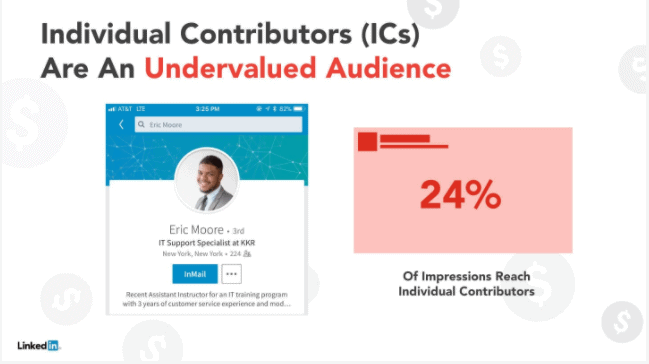One of the biggest mistakes B2B marketers makes today is robbing them of sales tomorrow: neglecting to target junior professionals.
That’s right—we’re talking about the IT support techs, the junior copywriters, the HR support specialists, and the junior account managers. In other words, the people who are not making the B2B buying decisions right now—but probably will be in about 3-5 years.
In this post, we’re going to explore why your B2B ad strategy should be targeting these people, instead of just focusing on senior decision-makers. Let’s get going!
Junior professionals become senior professionals faster than you might think.
According to LinkedIn’s career data, which is just about the most comprehensive on the planet, people rise through the ranks in a fairly short amount of time, depending on their industry. In general, though, it takes about 3-5 years for someone to go from junior pro to a senior manager.

Knowing what we do about the number of brand interactions that it now takes for a B2B buyer to go from prospect to purchaser—upwards of 20, sometimes more—doesn’t it make sense to start those interactions early?
If someone in the IT department sees your brand regularly when they’re online, and reads your content, and interacts with your social, they’re being primed to become a buyer—or influence buying behavior at their company—when they enter into those positions later.
B2B sales cycles are long.
As if you didn’t know, right? B2B sales cycles are so much longer than B2C. Sometimes they take years—and sometimes you end up working with multiple different buyers, as the one you began the sales interaction with leaves and another takes her place.
According to Amra Beganovich, founder of a pharma marketing agency, the one who takes the former buyer’s place could just be a former marketing assistant who knows you from the beginning of her career when she got a lot of value from your blog.”
That one who takes the former buyer’s place could just be a former marketing assistant who knows you from the beginning of her career when she got a lot of value from your blog. Now, she’s in a position to influence buying decisions, and your brand is the one that comes to her mind first.
Given that B2B buying decisions usually involve several people conducting their own research, then working to come to a consensus over time, that former assistant’s comfort with your brand could very well be the difference between a foot in the door and being left out in the cold.
Junior professionals are easier to influence.
It’s an unavoidable truth that younger people are more impressionable in terms of buying behavior—after all, they’ve had less time to become accustomed to buying from certain brands in a certain way. They’re more open to trying new things, exploring new brands, and experimenting with different ways of buying.

That’s why the 18 to 34-year old marketing demographic tends to be the most coveted, among B2C brands. Those brands know that hooking someone young makes it more likely they’ll continue buying from you, and of course, the younger they are when they make that first purchase, the greater their potential lifetime value will be.
Since junior professionals tend to be younger in age, targeting them with ads now can have a big payoff later.
Junior professionals are often the ones doing the most work and the most research.
How much research is delegated to people beneath the senior manager or executive status?
Plenty.
You’ve likely seen it in your company: when your department is searching for a new tool, a new platform, or a new vendor, much of the initial research is often delegated to a staffer who’s earlier in their career—the person who’s actually doing the most on-the-ground work, as opposed to those higher up who spend their time more on strategy or big-picture thinking.
Getting your ads in front of the people who are actually responsible for gathering data, making initial recommendations, and presenting options—even if those options will go through several rounds of culling by those who have final say—simply makes sense.
Serving ads to junior professionals now is a huge investment in your business’s future.
No brand sets out to succeed for a year, and then fade into obscurity. You want your brand to be sustainable—to grow, and continue growing, for years to come.
So, if that’s the case, why are so many B2B brands not only neglecting, but excluding, tomorrow’s B2B buyers from their ad targeting? LinkedIn’s research, for example, showed that of all the impressions that are served by their own enterprise advertising clients, only 24% reach what they call “individual contributors,” or junior pros.
The rest are targeting senior executives, department heads, and others high up on the totem pole.
No matter how you look at it, focusing that much on the people who can buy from you today is a strategy that puts far too much weight on the short-term, and neglects the long-term.
Expanding your B2B ad strategy to junior professionals is also an investment in branding.
We’ve been saying for a while now that companies need to be investing in branding more than one-off campaigns.
It’s those long-term, trust-building, reputation-building branding efforts that take B2Bs from being one in the crowd to a household name (and if you think you don’t need to be shooting to become a household name, here’s why you’re wrong).
Branding is what keeps customers coming back to you over time, what gets them to give you a second chance if they have a less-than-ideal experience, and what encourages them to spread the word about your business.
It’s critical if you want to stand out from the thousands of other brands that are competing for your customer’s attention on a daily basis.
Investing in cultivating that trust, respect, and good feeling with people who may not be customers today, but certainly could be in a year or three is just common sense.
This doesn’t stop once you make the sale. Let’s say a current client needs to talk to your support, or get questions answered, or clear up confusion about how a product works or who’s delivering it. Guess who’s going to be the person they ask to call you?
It won’t be the CIO, or the CMO. It will be a junior professional—and their direct experience with you will go far in terms of whether or not that client stays happy with you for the long run.
Junior professionals are the most undervalued B2B demographic there is. By targeting them now and investing time and effort in creating those relationships, you’re setting your brand up for success further down the line.
Need help crafting your new B2B ad strategy? Get in touch!







